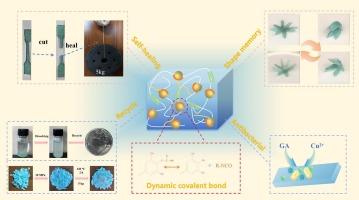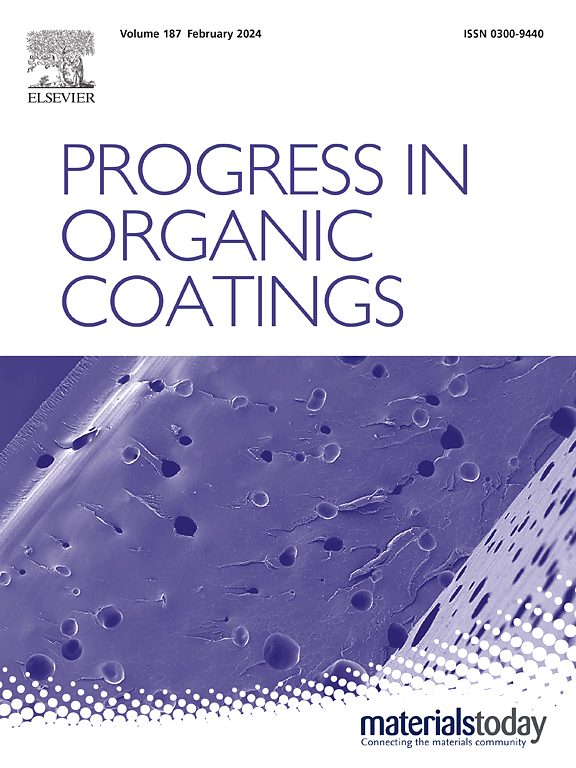Synthesis of a gallic acid-based self-healing waterborne polyurethane with a thermo-responsive dynamic phenol-carbamate network for enhanced mechanical strength, antimicrobial activity, and shape memory properties
IF 6.5
2区 材料科学
Q1 CHEMISTRY, APPLIED
引用次数: 0
Abstract
To expedite the advancement of multifunctional next-generation smart materials, it is imperative to create polymers derived from renewable, green bio-based resources. This paper presents a direct synthesis of thermo-responsive aqueous polyurethanes by combining gallic acid (GA) with isocyanate groups to form a dynamic phenol-carbamate crosslinked network and the incorporation of the metal-organic framework Cu-MOF-2 for synergistic effects. The resulting GA-based polyurethane (MOF-GWPU) exhibits excellent thermal stability and mechanical properties, achieving an ideal balance between mechanical strength and self-healing efficiency. The MOF-GWPU film demonstrates strong antimicrobial efficacy against Escherichia coli and Staphylococcus aureus, highlighting its exceptional antibacterial performance. The thermo-responsive dynamic covalent bonds enable the MOF-GWPU film to rapidly revert from a temporary shape back to its original form. Post-processing experiments further indicate that the crosslinked GA-PU polymer can be efficiently recycled through solution casting and hot-pressing techniques. This design offers a novel approach and valuable insights for advancing the development of multifunctional smart polymers derived from bio-based resources.

合成具有热响应动态苯酚-氨基甲酸酯网络的没食子酸基自愈合水性聚氨酯,提高机械强度、抗菌活性和形状记忆性能
为了加快多功能下一代智能材料的发展,必须从可再生的绿色生物资源中提取聚合物。本文介绍了一种直接合成热响应水性聚氨酯的方法,即通过没食子酸(GA)与异氰酸酯基团结合形成动态苯酚-氨基甲酸酯交联网络,并加入金属有机框架 Cu-MOF-2 以产生协同效应。由此产生的 GA 基聚氨酯(MOF-GWPU)具有出色的热稳定性和机械性能,在机械强度和自愈效率之间实现了理想的平衡。MOF-GWPU 薄膜对大肠杆菌和金黄色葡萄球菌具有很强的抗菌效果,凸显了其卓越的抗菌性能。热响应动态共价键使 MOF-GWPU 薄膜能够迅速从临时形状恢复到原始形状。后处理实验进一步表明,交联的 GA-PU 聚合物可以通过溶液浇铸和热压技术进行有效回收。这一设计为推进生物基资源多功能智能聚合物的开发提供了一种新方法和宝贵见解。
本文章由计算机程序翻译,如有差异,请以英文原文为准。
求助全文
约1分钟内获得全文
求助全文
来源期刊

Progress in Organic Coatings
工程技术-材料科学:膜
CiteScore
11.40
自引率
15.20%
发文量
577
审稿时长
48 days
期刊介绍:
The aim of this international journal is to analyse and publicise the progress and current state of knowledge in the field of organic coatings and related materials. The Editors and the Editorial Board members will solicit both review and research papers from academic and industrial scientists who are actively engaged in research and development or, in the case of review papers, have extensive experience in the subject to be reviewed. Unsolicited manuscripts will be accepted if they meet the journal''s requirements. The journal publishes papers dealing with such subjects as:
• Chemical, physical and technological properties of organic coatings and related materials
• Problems and methods of preparation, manufacture and application of these materials
• Performance, testing and analysis.
 求助内容:
求助内容: 应助结果提醒方式:
应助结果提醒方式:


